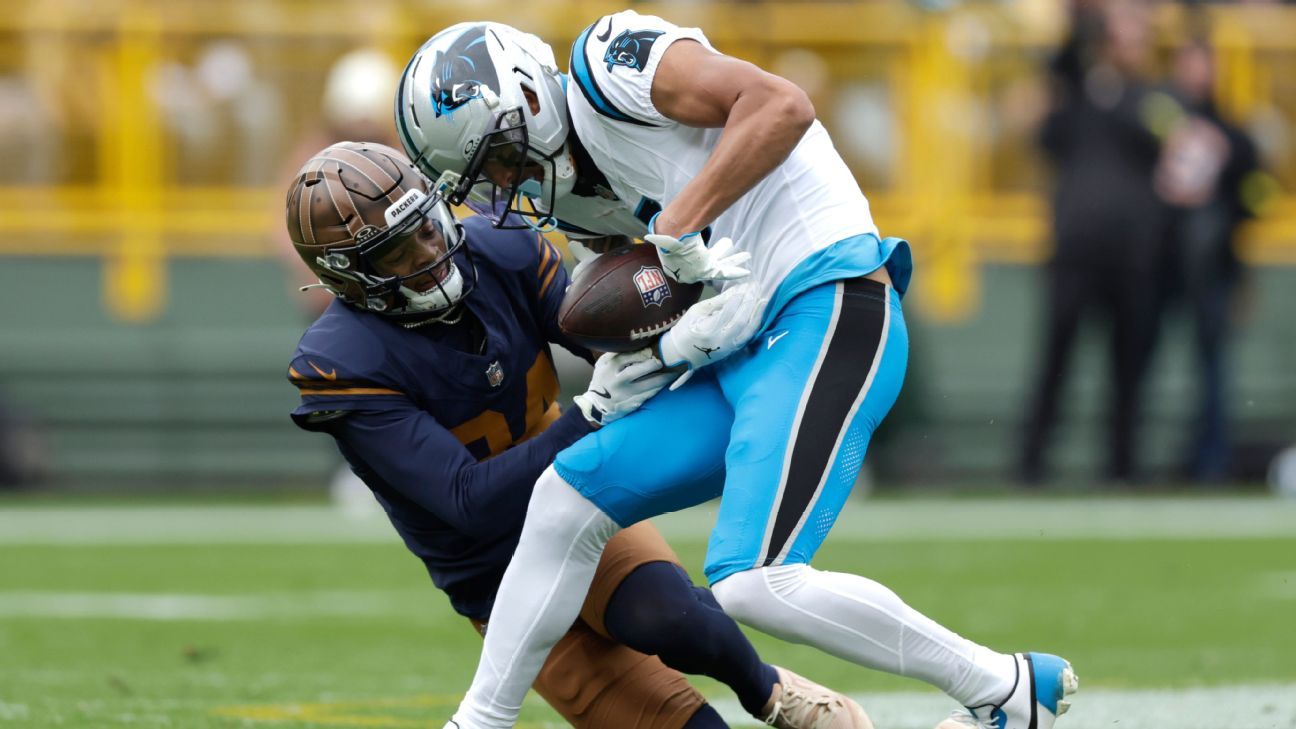College Football Playoff Week 11 lessons: The SEC is rising and the Big Ten is sweating

This week, we got a glimpse of the ongoing conflict between the Big Ten and the SEC that will most likely keep the College Football Playoff at 12 teams next year.Mississippi State president Mark Keenum, who heads the CFP board of managers, went on “The Paul Finebaum Show” on Friday and made it clear the SEC doesn’t want a playoff with multiple automatic qualifiers for power conferences. The Big Ten does.If they can’t agree, nothing will get done and another year of talking about how to expand the Playoff will lie ahead. With four weekends of football left until selection day, this CFP race is setting up to show why each conference is taking the stance it does.What we learned about the CFP in Week 11 is the SEC’s chances of getting at least four teams in are going up, and the Big Ten’s hopes of getting more than three in are going down.B1G dayIt was a heck of a day of football in the Big Ten.The conference had the catch of the day by Indiana’s Omar Cooper Jr. and the throw of the day by Oregon’s Dante Moore as the No. 2 Hoosiers and ninth-ranked Ducks registered thrilling road wins with late-game dramatics.There was a Top 25 upset with No. 23 Washington falling to Wisconsin in Madison, and the Big Ten’s two Heisman Trophy contenders, Ohio State’s Julian Sayin and Indiana’s Fernando Mendoza, bolstered their resumes.As entertaining as it was, especially for those who appreciate football played in football weather, it was far from a perfect Saturday in the Big Ten, as two more CFP contenders almost certainly got tossed into the done pile.Moore’s tight-window dart to Malik Benson helped set up Atticus Sappington’s game-winning field goal, and the Ducks beat No. 20 Iowa 18-16.“I guess that’s what they call Big Ten football,” Oregon coach Dan Lanning said.Meanwhile, as relieving as it must have felt for Wisconsin coach Luke Fickell to end a six-game losing streak a few days after Badgers athletic director Chris McIntosh announced Fickell would be back next season, the loss nuked Washington’s chances of making a late Playoff push.Both the Hawkeyes (6-3) and Huskies (6-3) needed to run the table to get into the at-large conversation, but the best they’ll be down the stretch is spoilers.A Big Ten title game matching Ohio State and Indiana still seems inevitable. Meanwhile, the Ducks appear to be in the enviable position of having enough tough games left on their schedule to climb in the rankings while still holding a potential mulligan. Oregon closes with Minnesota, No. 19 USC and Washington. The Ducks have a 94 percent chance to make the CFP, according to projections from The Athletic’s Austin Mock.Meanwhile, Ohio State (9-0) and Indiana (10-0) are now virtual Playoff locks, with a better than 99 percent chance to make the field.The Trojans (7-2) seem like the Big Ten’s best chance for a fourth CFP team. Lincoln Riley’s team used some fake-punt shenanigans in its win over Northwestern on Friday and will get an extra day to prepare for Iowa. Then a road trip to Oregon looms for USC.No. 21 Michigan (7-2) might like a word, considering its recent history against Ohio State.Big Ten commissioner Tony Petitti has pushed for multiple automatic qualifiers for power conferences — including four for the Big Ten and SEC — as a way of taking the selection committee’s subjectivity out of the selection process. The idea was that the Big Ten’s CFP spots would be determined by a combination of conference standings and play-in games.Not only would that system assure the Big Ten of a quarter of a 16-team field, but it would also keep more teams realistically in contention deeper into the season. Iowa, Washington, Nebraska, Minnesota, Illinois and Northwestern would still be alive to make a play-in game as the Big Ten’s sixth-place team.Petitti, a former Major League Baseball executive, believes keeping as many teams in the race as deep into the season as possible is generally good for the sport, even though it’s anathema to most college football fans.With three regular-season weekends left, five Big Ten teams (Ohio State, Indiana, Oregon, Michigan and USC) are realistically alive. The other 13 are playing for bowl positioning, which isn’t as interesting as it used to be for fans.Last year, the Big Ten put four teams in the first 12-team CFP: Oregon, Penn State, Indiana and Ohio State. The fourth-place Buckeyes ended up winning the whole thing. The Buckeyes, Hoosiers and Ducks give the Big Ten three teams that could be the last standing again, but the way this is playing out is likely to motivate Petitti to dig in even harder for expansion beyond 16 teams and automatic bids.SEC takeoverThe SEC’s top tier of four teams had a fairly uneventful weekend, with No. 3 Texas A&M, No. 4 Alabama, No. 5 Georgia and No. 6 Ole Miss all winning by double-figures.A&M put Missouri’s CFP hopes to rest, but No. 16 Vanderbilt remained in the race thanks to a rousing Diego Pavia-led comeback and overtime victory against Auburn.No. 11 Texas (7-2) and No. 12 Oklahoma (7-2) were both off before huge road games. The Longhorns go to Georgia next week, and the Sooners to Alabama. Texas still has Texas A&M to play, so if any team is going to find its way into the field at 9-3, it’s probably the Longhorns. The Aggies (9-0) also fall into the virtual lock category, with games remaining against South Carolina and Samford before going to Texas.Georgia (8-1), Ole Miss (9-1) and Alabama (8-1) all have a better than 90 percent chance to make the field, according to Mock’s projections.The SEC heads down the stretch with seven teams alive, four practically in, and a real good chance to make it five. When the new rankings come out Tuesday, the SEC should have seven of the top 14 teams, with Vanderbilt moving up and No. 14 Virginia and No. 15 Louisville sliding back.When SEC commissioner Greg Sankey talks about Playoff formats, he uses the word “displacement” a lot. What he is referring to is a team being ranked high enough to be in the field getting bumped out by a lower-ranked team that gets in via automatic qualification.The current format reserves five bids for conference champions. Last year, that led to Alabama being ranked 11th in the final Top 25 but getting nudged aside when Clemson won the ACC title game. The SEC ended up with three teams in the CFP, and many in the league were not happy.The way things are going in the ACC this year, something similar could happen again. And the best Group of 5 champion is almost certainly coming from outside the top 12 this season, too.On Tuesday, the projected bracket had No. 14 Virginia and unranked Memphis displacing Texas and Oklahoma. Sankey understands that a minimal amount of conference inclusion will keep him and the other commissioners out of court and from getting called before Congress.But he and his constituents are in no rush to sign up for any model — no matter how big — that could artificially limit the number of teams the SEC could put in the Playoff.Big 12 runs through LubbockNo. 8 Texas Tech rolled No. 7 BYU in the Big 12’s game of the year, putting the Red Raiders in the driver’s seat to make the conference title game.A rematch in Arlington, Texas, on Dec. 6 could set up the Big 12 to get two teams in the field after being relegated to one last year. Though that would require BYU (8-1) beating the Red Raiders (9-1) next time around, and Saturday’s game certainly did not provide much hope for that happening. Only Texas Tech’s red zone issues — a season-long problem — kept the 29-7 final from being far more lopsided.The Cougars shouldn’t feel too bad. All nine of Texas Tech’s victories have been by at least 20 points, and the one game the Red Raiders lost was without quarterback Behren Morton.It should be noted, Cincinnati (7-2) is also in contention to make the Big 12 title game and hosts BYU in two weeks.If the Red Raiders continue to roll, the more interesting question from the Big 12 might be: Can Texas Tech earn a first-round bye?Getting Ohio State and Indiana out of the top four will be difficult without some type of significant upset between now and championship weekend. But there is enough potential volatility in the SEC to open a path for the Red Raiders, who certainly look the part of a top-four seed.Three more things you need to know about the Playoff right now• The ACC continued to descend into madness. Virginia’s good fortune finally ran out against Wake Forest, which handed the Cavaliers (8-2) their first conference loss. With a chance to grab a share of the lead in the ACC, Louisville lost in overtime to Cal. That leaves a four-way tie for first among UVA, No. 17 Georgia Tech, No. 24 Pitt and SMU at 5-1 and Duke at 4-1. The Blue Devils fell to 5-4 overall by losing at UConn. The situation doesn’t look great for the ACC getting more than one bid. And here’s something to chew on: If Duke wins the conference at 9-4, could the ACC be shut out altogether?• ESPN’s David Hale noted the ACC now has six losses to teams outside the power conferences. The SEC, Big Ten and Big 12 have combined for eight losses outside the P4. The ACC has two more chances to change its trajectory outside the conference: No. 10 Notre Dame plays at Pitt next Saturday, and Georgia Tech plays Georgia to end its regular season. If the ACC can win those two games, the winner of the Georgia Tech-Pitt game becomes a much stronger at-large contender. Pitt also plays Miami at the end of the season. The 18th-ranked Hurricanes beat the Irish to start the season, you might remember — even if it seems the CFP selection committee did not.• Tulane’s victory Friday night at Memphis provided another twist to the American Conference race. Now, North Texas is best situated to get to the league title game. The next big game is Saturday, when Navy (7-2) hosts South Florida (7-2). The Bulls tore up North Texas but blew a fourth-quarter lead to Memphis. Tulane plays neither USF nor UNT, so the tiebreakers could be a mess and involve CFP rankings and computer ratings.









